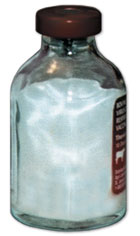 Tips for Handling Vaccines
Tips for Handling Vaccines
Vaccine effectiveness depends on proper handling.
To be effective, vaccines must be properly handled. Chris Chase, Department of Veterinary and Biomedical Sciences, South Dakota State University, says the biggest thing with modified-live virus vaccines is to make sure you only reconstitute the amount that can be readily used within about an hour or two.
"If you’re working a bunch of cattle over a 6- to 8-hour period, mix it up as you go and make sure the vaccine is protected from sunlight," he advises. "UV (ultraviolet) light can have a detrimental effect on vaccine, particularly the modified-live vaccines." Keep it cool, but also out of direct sunlight. Be sure to keep the lid on the insulated container. In cold weather, make sure the vaccine doesn't freeze.
"Check the expiration date before you buy it. You want to make sure the vaccine has not expired by the time you use it," says Chase.
"Make sure your syringes have been cleaned and rinsed. You don't want any residual disinfectant in them, or it will inactivate a modified-live virus vaccine," he says. It's best to use just boiling water to clean syringes. And if a syringe starts sticking, get new parts rather than use a lubricant, because it might leave a residue, as well.
Mark or color-code syringes with tape to make sure you never get them mixed up when giving more than one vaccine. You don't want to accidentally refill a syringe with the wrong vaccine, especially if one is a 2 cc dose and the other a 5 cc dose. Even if they are the same dosage, one of them might inactivate the other.
"An inactivated vaccine could have a negative effect on a modified-live virus," he explains.
"Try to buy vaccine in bottle sizes that you'll be using quickly. I've seen people buy clostridial vaccines in 50-dose bottles, and take out just a few doses at a time for young calves. The more times you puncture the lid, the more chance of contamination, and there's soon such a big hole that vaccine may come running out. Even though the 10-dose bottles are more expensive (per dose) than a 50-dose bottle, if you know you will be giving vaccine over a period of time, it's better to get it in smaller bottles," he says.
 Use a new sterile needle when drawing vaccine from the bottle; never put a used or dirty needle into the bottle.
Use a new sterile needle when drawing vaccine from the bottle; never put a used or dirty needle into the bottle.
"You want to make sure the vaccine is effective, and it can't be effective if it has been mishandled," says Chase.
[Click here to go to the top of the page.]








